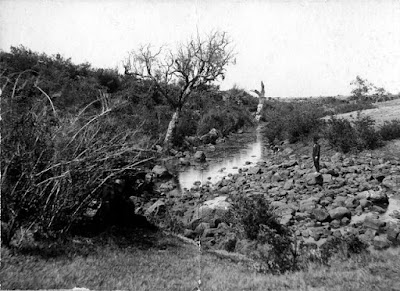Grades 6+ class, Coburg State School, 1910. Teacher Mr Patrick O'Hanlon.
Image courtesy Paul Sumner.
A while ago I wrote about school cadets at Coburg State School in an attempt to identify some of the cadets in the above photograph.
Since then I have done some more research on cadets at the school and have uncovered information about a disturbing incident that occurred later that year.
The photograph was taken in 1910, probably towards the start of the school year. Four of the boys in the photo are wearing their uniforms and two are wearing sailor suits, so may well have been members of the Naval Brigade. However, we also know that most, if not all, of the 19 boys pictured here would have been junior cadets, as military training was compulsory for all boys over 12 at that time.
This means that all of these boys would regularly make the trek from the school down Urquhart Street along the walls of Pentridge Prison to the Rifle Butts, which were located between Urquhart Street and Murray Road on the banks of the Merri Creek. It was a site at the back of the Prison where there was open country and rifle practice should not be dangerous, although I've read articles about wandering cattle and the occasional pedestrian crossing that area at their peril. (see Coburg Leader, 2 June 1900, 16 June 1900, 14 Sep 1901, 11 April 1903)
A 'regrettable incident' (HT J.E. 'Rusty' Sheehan's words) occurred at the rifle butts in December 1910, so must have involved at least some of the boys in the photograph shown above.
A letter Sheehan wrote to the Director of Education on 13 December 1910 reveals that some boys had been at the butts with their instructors Lieut of Cadets Downing and Mr Govan (another teacher at the school) for musketry practice. Before their departure from the school at 4.30pm, Govan took the 'senior non-com' to the office to get the necessary ammunition where the boy took an extra packet of ammunition without Govan's knowledge.
At the butts, each boy received one cartridge (they practiced with live ammunition), fired his shot then showed the teachers the cartridge to show that he wasn't hiding anything.
When the teachers left at 5.40pm to catch their train, they left a few boys behind to tidy up. The boys were left in the charge of the 'senior non-com', a boy who had 'always shown himself a serious-minded boy of excellent character and very earnest and particular about cadet work'.
Boys will be boys and the others started to make fun of the boy in charge. It developed into a row, a stone was thrown that hit the boy and he took up his rifle and threatened to shoot one of the boys teasing him. They got into a fight. There was a struggle and the rifle discharged. Some other boys started to jeer at him and dared him to shoot them as they ran away, so he fired over their heads then threw the remaining cartridges into the Merri Creek.
The teachers only learned of the incident when the police came to the school to investigate. The boy who fired the shots was expelled from the cadets and it was expected that the police would proceed against him in the Children's Court, although I have found no reference to the incident or any court case in the press of the day.
The fact that the boy deliberately took live ammunition with him on that day suggests that there was a history of him being teased by other boys in the group and that he was fed up with being bullied. If he was as serious and 'earnest' about his position of responsibility as the headmaster said, it easy to see how the others might have used this to annoy him. It is equally easy to see how it could get out of hand, as it did on this day. Amazingly, no one was hurt (or killed, for that matter).
I have not named that boy here, but my research reveals that in December 1910 he was 14 years old and lived in Union Street, Coburg. He did not serve in World War One, as many of the other boys did, but did his bit in the Second World War. I can only imagine how hard this incident must have been for his parents, his two brothers and the school. There is no indication in the school correspondence I read that the teachers or the other boys were disciplined, but I'm sure there would have been a thorough investigation of the matter.
(Information on the rifle butts incident comes from Letter 10/14473 dated 13 December 1910, Unit 273, Victorian Public Record Series 640 Central Inward Primary Schools Correpspondence, Public Record Office of Victoria)
The Mr Govan mentioned here was Woolston J. Govan.
Image couresty Australian War Memorial. Image P05248.052.
Govan was a qualified instructor of Junior Cadet Training and served for three years in the Victorian Scottish Regiment before enlisting in the 13th Light Horse in January 1915. At that time he was teaching at Mangalore.
Woolston Govan did not survive the war. He was hospitalised in Egypt in December 1915 with hepatitis and rheumatism and again in February 1916 with enteritis. Seemingly recovered, he went to France, disembarking at Marseilles on 23 March 1916. He died of heart failure just over a week later, on 2 April 1916, and was buried at Boeseghem Churchyard, near Aire, France. He was 24 years old.





































